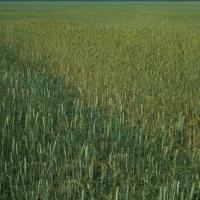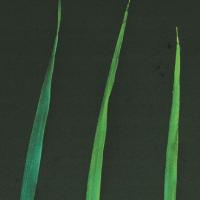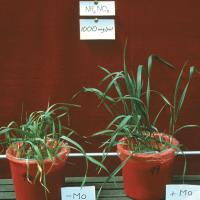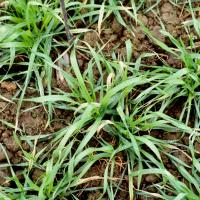Diagnosing molybdenum deficiency in cereals
Many sandplain soils in WA were molybdenum deficient in their natural state. Molybdenum deficiency is difficult to detect in the field and can decrease wheat yield by up to 30% before symptoms become obvious. Deficiency becomes more common as soils acidify. Molybdenum overuse can cause the disease molybdenosis in livestock grazing following pastures.
What to look for
- At low levels of nitrogen the crops are pale with some limpness.
- Patches of good growth often found on higher pH areas such as ash heaps or burnt windrows.
- As nitrogen levels increase, symptoms become more specific with all but the the oldest leaves pale green when nitrogen nutrition is adequate to high.
Paddock
- Middle leaves have a speckled flecking and mild yellow stripes.
- Leaf tips are scorched at high nitrogen levels.
- Severely deficient plants have white heads, shrivelled grain and delayed maturity.
Plant
What else could it be
| Condition | Similarities | Differences |
|---|---|---|
| Diagnosing nitrogen deficiency in wheat | Plant symptoms before head emergence | Nitrogen deficiency has more uniform paddock symptoms, no white or rat-tail heads or delayed maturity. Molybdenum deficient plants are also more likely to be wilted |
| Diagnosing potassium deficiency in wheat | Pale plants with leaf tip death that are more susceptible to water stress | Difference is potassium deficiency have no white or rat-tail heads, and more marked contrast between yellow and green sections of affected leaves |
| Diagnosing copper deficiency in wheat | White heads, dirty straw, shrivelled grain, late tillers, delayed maturity | Copper deficiency symptoms are worse on the youngest leaves and cause weak straw |
| Diagnosing stem and head frost damage in cereals | White heads, dirty straw, shrivelled grain, late tillers and delayed maturity | No leaf symptoms, plants worse on frost prone soils or locations independent of soil pH |
Where does it occur?

Soil type

Soil ph

Dry conditions

Spraying herbicide
- Acidic yellow sandy wheatbelt sands required molybdenum when initially cleared, but deficiency is becoming more widespread as soils acidify.
- Molybdenum deficiency is exacerbated in acidic soils and soils high in iron and aluminium oxides. It is particularly acute on acid wodjil soils.
- Molybdenum is relatively immobile in soil and can become unavailable to crops in dry conditions.
- The use of root-pruning herbicides, particularly groups A and B can induce molybdenum deficiency.
Management strategies

Spraying foliar

Soil application

Seed treatment

Lime application
- Foliar spray (effective only in the current season), seed treatment or soil fertiliser.
- As molybdenum is immobile in the soil topdressing is ineffective, only being available to the plant when the topsoil is wet. Mixing molybdenum throughout the topsoil improves availability due to more uniform nutrient distribution.
- In long term no-till paddocks frequent small applications of molybdenum via drilled, in-furrow application or seed treatment reduces the risk of plant roots not being able to obtain the nutrient in dry seasons.
- Deep-placed molybdenum increases the chances of roots being able to obtain enough molybdenum when the topsoil is dry.
- Liming productive acid soils to maintain topsoil pH above 5.5 is important for maintaining molybdenum availability.
- Molybdenum fertiliser has a very low residual life in highly acidic wodjil sandplain soils. Molybdenum seed dressing or using seed from alkaline soil paddocks is a cost-effective way of avoiding deficiency on these soils.
How can it be monitored?

Tissue test
- Use youngest fully-emerged leaf to test for molybdenum. Levels less than 0.075 milligrams per kilogram (mg/kg) indicate deficiency. Take paired good/poor plant samples when possible.
- There is no reliable soil test for molybdenum.
See also
Further information
Where to go for expert help
Page last updated: Wednesday, 6 May 2015 - 1:35pm





